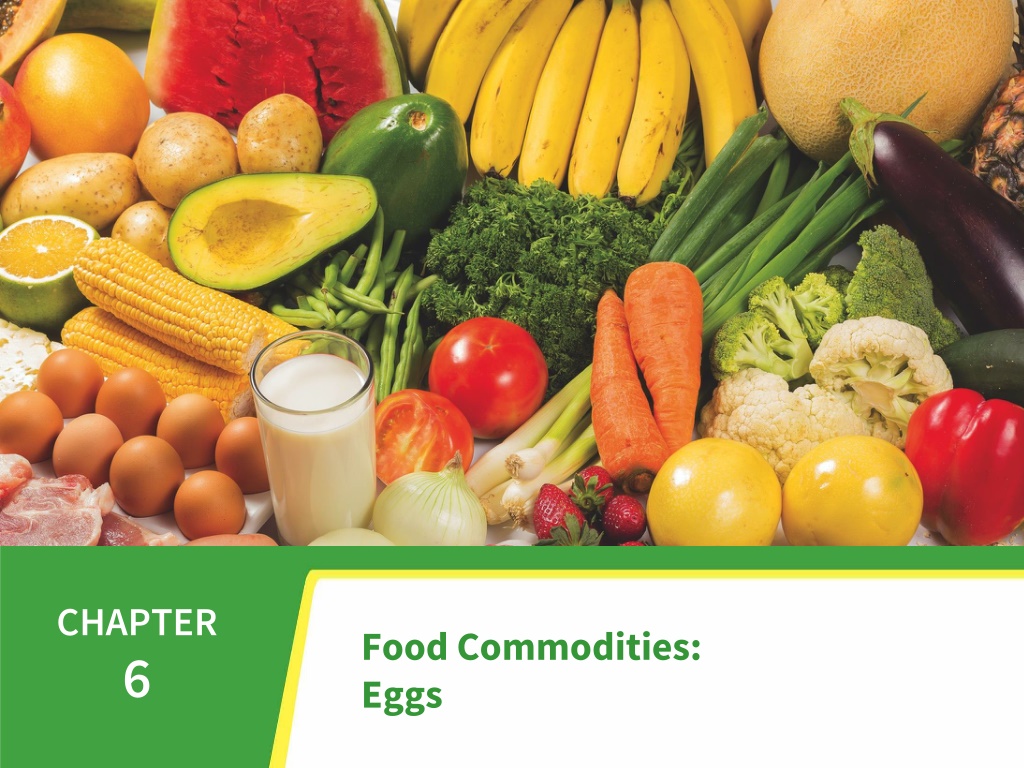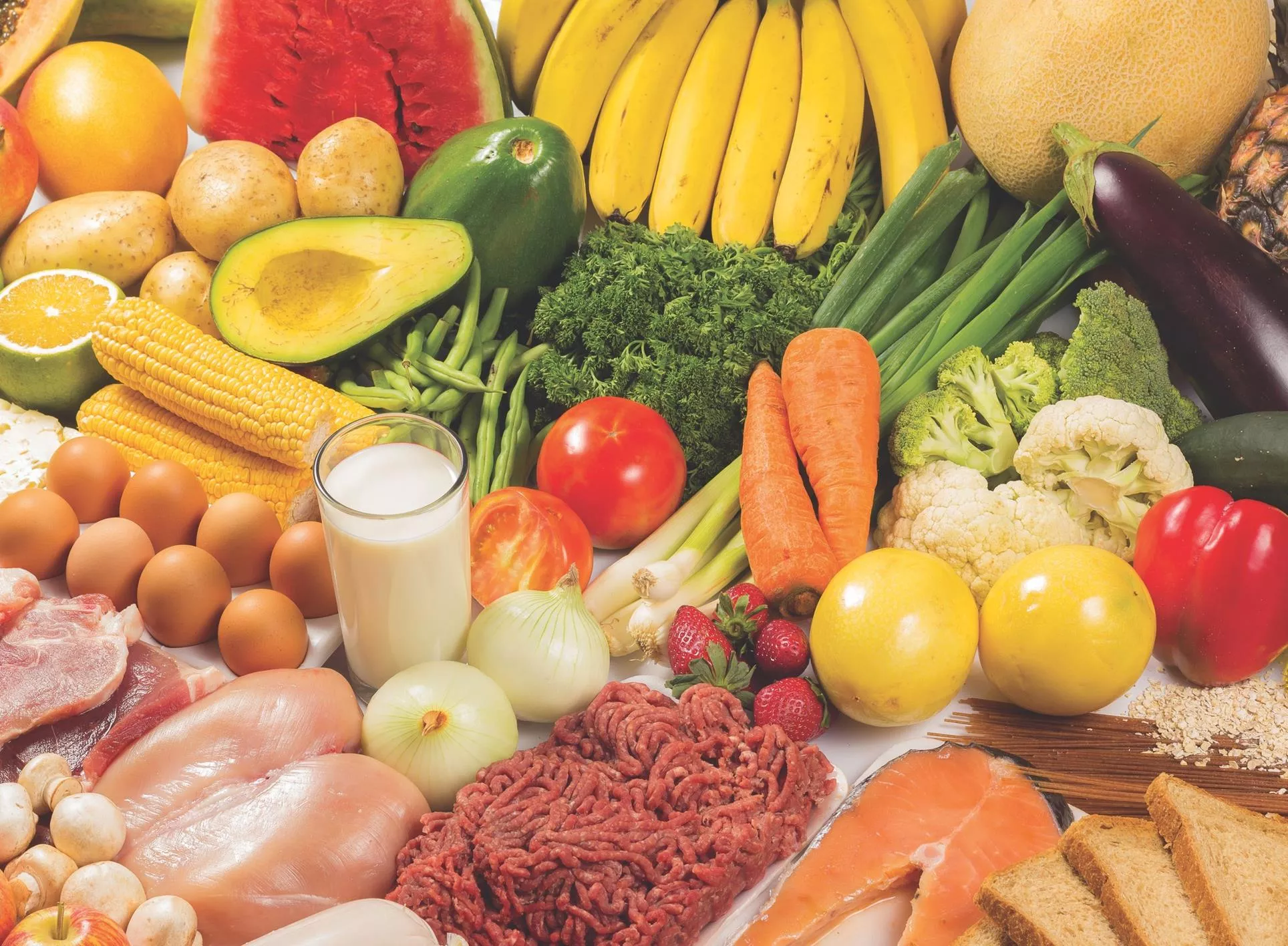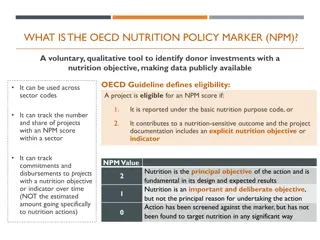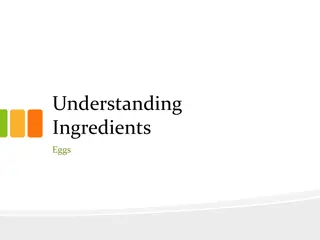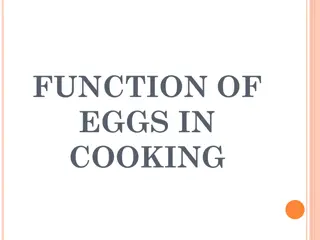All About Eggs: Nutrition, Dietetic Value, and Storage Guidelines
Discover the nutritional value of eggs, their importance in diets, and guidelines for buying and storing eggs. Eggs are a rich source of protein, vitamins, and minerals, making them a versatile and nutritious food choice. Learn how to choose fresh eggs, store them correctly, and incorporate them into a healthy diet.
Download Presentation

Please find below an Image/Link to download the presentation.
The content on the website is provided AS IS for your information and personal use only. It may not be sold, licensed, or shared on other websites without obtaining consent from the author. Download presentation by click this link. If you encounter any issues during the download, it is possible that the publisher has removed the file from their server.
E N D
Presentation Transcript
6 Food Commodities: Eggs CHAPTER 6 Food Commodities: Eggs 1
6 Food Commodities: Eggs Structure of an egg 2
6 Food Commodities: Eggs Average composition of eggs Whole egg White Yolk Protein Protein Protein 13% 1% 16% Lipid Lipid Lipid 12% 0.25% 32% Carbohydrate Carbohydrate Carbohydrate 0% 0% 0% Vitamins (B, A, D, E, K) Vitamins (B, A, D, E, K) Vitamins (B) 1% 0.5% 1% Minerals (calcium, phosphorus, iron, zinc, sulphur and selenium) Minerals (calcium, phosphorus, iron, zinc, sulphur and selenium) Minerals (calcium, phosphorus, zinc and selenium) 1% 0.75% 2% Water Water Water 3 73% 86.5% 48.5%
6 Food Commodities: Eggs Nutritional value of eggs Protein: Eggs are a source of HBV protein, albumin and globulin are in the white, livetin and vitelinare in the yolk. Lipids: Almost one-third of the egg yolk is saturated fat. The yolk is high in cholesterol. Carbohydrate: Eggs do not contain carbohydrates. Vitamins: Fat-soluble vitamins A, D, E and K are present in the yolk. B-group vitamins are present in the yolk but more so in the white. Minerals: Eggs are a source of calcium, zinc, sulphur, selenium and phosphorus. There is iron in the yolk. Water: Water is mainly present in the white. 4
6 Food Commodities: Eggs Dietetic value of eggs Eggs are a readily available, versatile food. Eggs contain HBV protein, so they are important in the diets of all age groups they are a good protein alternative to meat and fish. Eggs are cheap and nutritious, yet low in calories. The saturated fat and cholesterol present in eggs mean they should be restricted on low-calorie or low-cholesterol diets. Eggs are easily digested. Eggs are a good source of vitamins and minerals. Eggs lack both carbohydrates and vitamin C. 5
6 Food Commodities: Eggs Guidelines for buying eggs Buy fresh eggs and use quickly. Always check the best before date. Free range eggs cost more than mass produced eggs. Eggs should feel heavy for their size, and have a rough shell. Check shells to ensure there are no cracks or breakages. Check carton for information, e.g. size, class and quality. 6
6 Food Commodities: Eggs Guidelines for storing eggs Eggs should be stored in the refrigerator, e.g. the fridge door. Store eggs with pointed end downwards to prevent the chalazae from breaking and to keep the yolk intact. Keep eggs away from strong-smelling food because the shell is porous. Eggs should be used at room temperature, so remove from fridge one hour before use to prevent the shell cracking when boiling or curdling. Leftover egg whites can be stored in an airtight container in the fridge. Leftover yolks can be stored covered with water in the fridge. Always use eggs within the recommended time. 7
6 Food Commodities: Eggs Properties of eggs Coagulation Aeration/ foam formation Emulsification 8
6 Food Commodities: Eggs Coagulation Egg protein coagulates and sets when heated. Egg white protein coagulate between 60 65 C. Yolk protein coagulates between 65 70 C. Coagulation causes the protein chains to untwist and straighten and bond together around small pockets of water. When overheated, the protein clumps together, squeezing out the water. This causes curdling. 9
6 Food Commodities: Eggs Uses of coagulation Used when eggs are boiled, poached, scrambled, fried or turned into omelettes or custards. Used to make cr me caramel. When eggs are used to thicken, bind, glaze and coat, the principle of coagulation is used. 10
6 Food Commodities: Eggs Aeration/foam formation Whisking egg or just egg white brings bubbles of air into a mixture. Whisking also causes the egg protein to heat (by friction), which slightly sets the protein chains and makes them unravel and line up around the air bubbles (the addition of sugar aids aeration). This causes a temporary foam to form. To keep the foamy texture permanently in place, the mixture must be further heated or a setting agent like gelatine must be added. 11
6 Food Commodities: Eggs Uses of aeration/foam formation Used to make meringues, souffl s, pavlovas and sponge cakes. 12
6 Food Commodities: Eggs Emulsification Lecithin in egg yolk is a natural emulsifier. An emulsifier is a substance that causes mixtures that would normally separate, e.g. vinegar and olive oil, to stay mixed together. 13
6 Food Commodities: Eggs Uses of emulsification Used in making mayonnaise (oil, egg yolk and vinegar), hollandaise sauce (vinegar and butter) and in cake-making (sugar and fat). 14
6 Food Commodities: Eggs Effects of cooking on eggs Egg protein denatures and coagulates, causing it to set and harden, e.g. boiled egg. Egg white changes from translucent to opaque. Eggs shrink slightly. Sulphur in egg white protein reacts with iron in yolk to form iron sulphide, which causes the greenish colour on the outside of the yolk of hard-boiled eggs. Destroys pathogenic bacteria like salmonella. Loss of B-group vitamins, especially vitamin B1 (thiamine). Too much heat causes curdling. If overcooked, white becomes tough and rubbery, yolk becomes dry and crumbly. Egg albumin (white), which is soluble in cold water, becomes insoluble. 15
6 Food Commodities: Eggs Culinary uses of eggs Binding ingredients together, e.g. burgers, fish cakes (coagulation). Coating, e.g. breaded fish (coagulation). Protects food when frying. Glazing: Beaten egg brushed on baked foods makes them brown and shiny, e.g. scones (coagulation). Thickening, e.g. custard sauce (coagulation). Enriching the nutritive value of a dish, e.g. brown bread. Garnishing, e.g. chopped hard-boiled egg in salad or with dressed crab. Emulsifying, e.g. mayonnaise, hollandaise sauce. Aerating, e.g. sponge cake, meringue. Clarifying: Egg whites used to make jelly or stock (coagulation). Eaten on their own, e.g. boiled, poached, scrambled or fried. 16
6 Food Commodities: Eggs Key words for revision Aeration Barn Cage Coagulation Cornfed Egg quality assurance scheme Emulsification Free range Grading Organic Salmonella White Yolk 17
